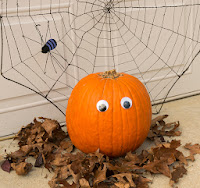Pumpkins for Halloween and After
Halloween is upon us again and there will be lots of
dressing up going on – princesses, witches, ghosts, skeletons, you name it.
Even pumpkins get a chance to join in with carved or painted faces, decorative
decals, wigs, fake ears, googly eyes and expressions that range from funny to
frightening.
I prefer to keep my pumpkin uncarved until after the holiday
because I have post-Halloween plans for it and don’t want it to spoil; it is
food, after all. So, after the big day/night, if you have a pumpkin you might
want to use in a different way, one that nourishes and delights without the
scary element to it, here are some suggestions:
Remember eating pumpkin seeds as a kid? This is where they
came from. Cut off the top of the pumpkin, roll up your sleeves, and dig right
in. It’s wet and stringy inside but getting the seeds out is worth it. This is
a great job for kids where they can be messy with permission. You can rinse off
the seeds or not, your choice. Lay them out on a sheet pan and drizzle them
with oil (and salt if you like salty seeds). Bake them in a 225-250 degree oven
for about an hour, stirring them occasionally. Check on them periodically. If
they seem dry or are beginning to brown, take them out. Cool them down before
eating.
Peeling off the skin isn’t easy but it is less difficult
when the pumpkin is soft. Cut the pumpkin in half. Scrape out the seeds (if you
haven’t already), and turn the halves cut side down on a flat sheet with sides.
Add a layer of water to the pan and bake at about 350 degrees for 45 minutes or
more (it depends on the size of the pumpkin). When a fork is easily inserted
into the skin, remove from the oven and cool. The skin should come off easier
now. Mash the pumpkin and use in your favorite recipe.
You may want to use smaller, sweet pumpkins for your recipes
instead of the Jack o’ Lantern size. I have used both – and butternut squash as
well. The puree from any of them can be used in soups, smoothies, cakes, pies,
pancakes, waffles, muffins. If the cooked pumpkin insides are too moist, let
the excess moisture drain off in a sieve.
Pumpkin pieces can be baked, steamed, boiled, and
microwaved. Use the method that most suits you. I plan to make pumpkin soup, as
I do each year. What I don’t use, I freeze, to be used another day, in another
way. Enjoy your pumpkin and…
HAPPY HALLOWEEN!
Here are some great ways to use your pumpkin:
For some lower-sugar, delicious-sounding recipes:
http://www.yummly.com/recipes/healthy-low-sugar-pumpkin







